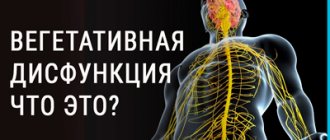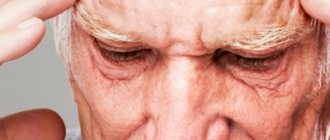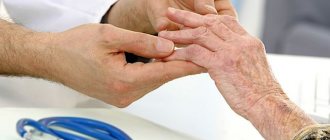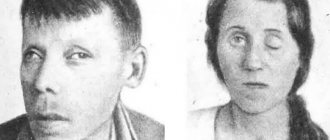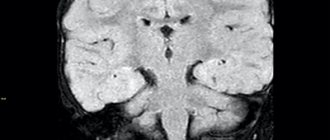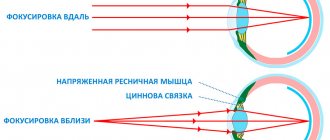A sympatho-adrenal crisis, also called a panic attack, is one of the manifestations of VSD (vegetative-vascular dystonia) of the hypertensive type.
This condition is not a disease, but a condition that manifests itself in the form of an acute attack, which is accompanied by an increase in heart rate, chest pain, a sharp rise in blood pressure, as well as an emotional feeling of fear.
The most common time for a crisis to occur is the second half of the day or night.
This fact is explained simply - during the day the body accumulates both physical and emotional fatigue, which can cause a panic attack.
Read more about panic attacks in our materials:
What happens during a crisis
Let's take a closer look at what happens during the onset of a sympatho-adrenal crisis.
Physical manifestations: a headache occurs, breathing becomes difficult, a feeling of lack of air appears, trembling occurs throughout the body, the sensitivity of the skin may be impaired, even a light touch causes pain, the limbs become cold, the body temperature rises.
In addition, as mentioned above, the heart rate increases and blood pressure rises.
At the time of a sympathoadrenal crisis, the human body experiences an overdose of adrenaline, which is released into the blood in a very significant volume.
Emotional manifestations: the patient develops a feeling of fear, often the person experiences fear of imminent death, unreasonable horror, ceases to trust others and believes that he is in danger.
As a rule, the duration of a crisis does not exceed 1-2 hours , although some patients claim that in fact a panic attack lasts much longer - up to 8 hours. However, even in such a short period, the body is subjected to a colossal test and experiences great stress.
The end of the attack occurs suddenly and is characterized by a feeling of powerlessness and weakness.
The intense work of the kidneys during a crisis results in copious urination, and the urine becomes very light.
After a crisis, it is recommended to remain calm, try to relax or distract yourself with some pleasant activity. This is necessary so that thoughts about the experience do not provoke a second attack.
At the moment, medical practice shows that the treatment of sympathoadrenal crises is quite successful.
Modern techniques and medications, selected by a professional doctor, have a positive effect and help cope with this condition. However, without the desire of the patient himself to overcome the panic state, the specialist will not be able to help fully.
Therefore, only through interaction between the doctor and the patient can the maximum effect be achieved and individual factors that provoke the development of a sympatho-adrenal crisis be overcome.
How to treat manifestations of a vegetative crisis
To treat a vegetative crisis, an integrated approach is used, which includes not only medications. In accordance with the patient’s complaints, the doctor determines the duration of the attacks, the severity of the symptoms, and only then prescribes medications. In addition, the patient must learn to overcome attacks independently.
Drug treatment
For this disease, symptomatic therapy is prescribed. To stop an attack, the following may be prescribed:
- for cardiac dysfunction - Valocordin, Corvalol or Anaprilina;
- to eliminate anxiety - Relanium or Clonozepam;
- A course of treatment with antidepressants under medical supervision is also prescribed.
In addition, it will be necessary to treat somatic pathologies and abnormalities in the functions of the central nervous system identified during the diagnosis. The same actions can be used to stop an attack of vegetative crisis.
Non-drug treatment
A person diagnosed with a vegetative crisis must learn to identify the symptoms of an approaching attack and overcome it on his own. Breathing exercises are suitable to eliminate the problem. With proper and slow breathing, a large amount of oxygen enters the body, which helps reduce the severity of symptoms that appear during an attack. The supply of carbon dioxide to the body is also effective. For this purpose, you can use a paper bag to exhale and inhale into it.
If there is a suspicion that an attack has begun, the patient is advised to change the environment. To do this, you need to leave the room or transport, try to pay attention to the surrounding nature to distract your thoughts.
Causes of crises
The very concept of “crisis” in the name of the condition under consideration indicates the presence of an extreme situation for the body, which leads to a negative reaction. What reasons can provoke sympathoadrenal crises?
These can be either internal psychological or physical problems, or external factors that cause emotional disorders.
Internal psychological reasons
People who are used to suppressing their emotions often suffer from panic attacks.
They cannot allow themselves to fully experience any shocks, both positive and negative, and as a result live in a state of stress.
However, emotions accumulated over a long period can negatively affect not only a person’s moral state, but also the body, finding a way out in a sympatho-adrenal attack.
Bad habits can also be included in this category of influencing factors.
Dangerous, unpredictable and difficult to predict - hepatic encephalopathy. What methods of diagnosis and treatment does modern medicine offer? Fruitless verbosity or resonant thinking. Real life examples of violations. Which brain centers are affected in such cases.
Internal physical reasons
These include various health disorders that can provoke a sympatho-adrenal crisis.
Among them:
- a neoplasm (tumor) in the adrenal medulla, which contributes to the release of a high volume of adrenaline into the blood (and regardless of the psychological state of the patient);
- disorders that increase stimulation of the central part of the sympathetic system in the spinal cord (tumor of the spinal cord, spine, ischemia);
- the presence of pathological impulses of areas of the brain associated with the sympathetic system and hypothalamus (similar to epileptic seizures);
- the presence of a neuroinfection, as well as a past illness associated with a neuroinfection;
- suffered traumatic brain injuries;
- disruption of the normal balance of hormones in the body;
- some disturbances in the functioning of the cardiovascular system;
- some diseases of the gastrointestinal tract and digestive system.
External factors
First of all, this category of reasons includes emotional stress arising as a result of any events affecting the patient.
They can be both positive and negative (more often they provoke a panic attack).
With a strong psychological shock, the brain gives the adrenal glands a command to release large amounts of adrenaline, which leads to a sympatho-adrenal crisis.
In addition, an external factor may be the tendency of close relatives to have panic attacks, which can cause a hereditary predisposition.
It should be noted that in one patient a sympatho-adrenal crisis can be provoked by different factors, and they will not always be the same during repeated attacks.
Course and prevalence
Panic disorder usually begins at a young age, less often in childhood and adulthood. According to research results, about 1.7% of the US adult population had symptoms of panic disorder (women are 2-3 times more likely to get sick). The disease has a wavy course; about half of the patients generally recover, the rest lead a relatively normal life, despite the persistence of symptoms and the presence of relapses.
The protracted course of panic disorder is facilitated by inadequate and untimely treatment measures. Anxiety disorders, including panic, are diagnosed in only 50% of patients with obvious symptoms. Fewer than 50% of patients receive any treatment and less than 30% receive adequate therapy.
Characteristic symptoms and signs
The sympatho-adrenal crisis develops quite rapidly, and, as a rule, the symptoms appear in aggregate.
Sympathetic adrenal crisis has the following characteristic symptoms:
- difficulty breathing, feeling of heaviness, tightness in the chest;
- feeling of cold or heat, the appearance of tremors of the limbs;
- paleness of the skin;
- a sharp increase in blood pressure, vasospasm;
- headache, throbbing sensation;
- increased heart rate, arrhythmia;
- dry mouth;
- emotional feeling of groundless horror, fear of death.
It should be noted that even the manifestation of symptoms can provoke a relapse of a sympatho-adrenal crisis, so it is very important to try to keep yourself “in control” during the onset of an attack.
First aid for an attack
Emergency care for sympatho-adrenal crisis is most often not necessary. A person can overcome an attack on their own, especially if they are able to take control of their condition. An attack requires the correct response from those around the patient. Excessive attention and anxiety about health can fix unwanted behavior. It is important to act in such a way as not to increase a person’s anxiety and experiences.
If an adrenal crisis has begun, you need to calm the patient, ensure a sufficient flow of fresh air, and unfasten constricting clothing. Can be laid horizontally. Of the sedatives, it is worth using Corvalol or Validol, Captopril. It is advisable to measure the pressure. For high blood pressure, you can give medicine that the patient usually uses to control hypertension.
If there is no improvement after 15–20 minutes, it’s time to call an ambulance. The arriving doctor will inject Relanium. To slow down the excessive activity of the sympathoadrenal system, it may be suggested to administer Obzidan or Verapamil.
Treatment of sympatho-adrenal crisis
The treatment process usually combines the use of medications and psychotherapy . Preventive measures and the patient’s compliance with certain rules of life are also important.
Emergency assistance during a seizure
Usually, emergency care for a sympathoadrenal crisis is not required, because when an attack approaches, the patient can cope with it independently, taking control of his psycho-emotional state.
However, in difficult cases, it is possible to use sedatives , which quickly relieve the symptoms of a crisis, or other effects according to the symptoms (for example, using a drug to lower blood pressure).
Drug treatment
For treatment at the first symptoms of sympatho-adrenal crisis, the following groups of drugs are used :
- Tranquilizers. For example, alprazolam, phenazepam. Used to reduce the excitability of the central nervous system (CNS). Drugs in this group are also prescribed for the prevention of attacks. However, you should know that tranquilizers do not eliminate the cause of the crisis, but only relieve symptoms, so long-term use of such drugs is not recommended. As a rule, they are prescribed at the beginning of treatment, before the causes of panic attacks are identified.
- Beta blockers. Drugs in this group neutralize the effect of adrenaline, therefore they are used to stop an attack or prevent a crisis when the first symptoms appear. Such drugs include atenolol, anaprilin.
- Antidepressants (Paxil, Cipralex). To obtain a positive effect, such drugs are recommended to be used for a long period (6-12 months). However, after discontinuation of antidepressants, a relapse of sympathoadrenal crisis is possible.
- Herbal medicines that have a sedative effect (sage, motherwort, valerian and others). Used as an alternative to complex sedatives. A positive effect is achieved after taking a course lasting from 6 to 12 months.
It should be noted that in no case should you choose medications on your own; only a qualified doctor should prescribe any drugs to overcome a sympatho-adrenal crisis.
Psychotherapeutic treatment
The patient’s work with a psychotherapist allows one to achieve good results in overcoming panic attacks.
An experienced doctor will help identify the causes of crises, and then work through and neutralize them together with the patient.
At the moment, there are several methods that can be used to solve the problem of sympatho-adrenal crises, so it is possible to select a specific treatment technology individually for each specific case.
Treatment of panic attacks: psychotherapy
Psychotherapy is the only way to get rid of panic attacks once and for all. Moreover, in contrast to popular belief, a psychotherapist will not “talk and calm you down,” but, on the contrary, through energetic psychotherapeutic work together with you, he will lure you out of the depths of the unconscious and resolve the cause of panic attacks. We use several psychotherapy techniques to treat panic attacks. Taking into account the patient’s condition and wishes, therapy is proposed that brings the fastest and most complete results. After 1-2 months of therapy, our patients usually feel absolutely normal.
Prevention measures
Factors such as diet, daily routine, and physical activity are not decisive for overcoming attacks. However, following simple preventive measures will reduce the frequency of crises and soften their course.
Prevention measures include:
- walks in the fresh air, moderate but regular physical activity;
- good sleep;
- proper nutrition, taking the necessary vitamins and minerals, it is advisable to divide food into smaller portions, but increase the number of meals;
- refusal of alcoholic drinks and energy drinks;
- reduce the time spent watching TV and reading news on the Internet to reduce the risk of negative emotions;
- It is recommended to avoid stressful situations if possible.
Why does a vegetative crisis develop?
At present, the sources of this problem have not been fully investigated. Although some factors have been identified that can provoke the onset of a vegetative crisis. These include:
- tendency at the genetic level;
- hormonal imbalances (menopause, pregnancy, abortion);
- frequent stress, mental disorders (death of a loved one, difficulties with work or personal life);
- endocrinological pathologies;
- disturbances in the functions of the central nervous system;
- heavy physical activity;
- alcohol addiction;
- long-term treatment with potent drugs.
Scientists and psychotherapists have created a general description of subjects predisposed to this disease. Representatives of the weaker sex are more susceptible to vegetative crisis, who are characterized by the presence of:
- artistry;
- instability of thoughts;
- inclinations to dramatize any situation;
- constant expectation of troubles, fear of them;
- inadequate response to criticism;
- constant desire to improve your own figure.
It is precisely such people who are prone to developing unreasonable panic attacks, in which there is a feeling of anxiety and fear. Moreover, somatic symptoms are pronounced.
Other perivascular crises
CSF crisis, hemolytic crisis, vagoinsular crisis, and vegetative-vascular paroxysm have similar symptoms
However, the causes of all these attacks are different, therefore treatment is selected individually in each case.
That is why, if alarming symptoms appear, you should consult a doctor who, after conducting diagnostic measures, will be able to accurately determine the type of crisis and prescribe the necessary course of treatment.
Diagnosis of the condition
Signs of a panic attack can be a manifestation of a disease of the endocrine system, cardiac and pulmonary pathology. Therefore, at the first stage, a diagnostic search is prescribed, which includes:
- blood pressure measurement;
- ECG registration;
- urine test for catecholamine excretion;
- complete blood count, biochemistry, sugar, electrolytes, cortisol;
- Ultrasound of internal organs, thyroid and adrenal glands;
- chest x-ray;
- MRI of the brain.
Based on their results, additional examination may be necessary, as well as consultations with a cardiologist, gastroenterologist, endocrinologist, pulmonologist, neurologist and psychiatrist, who will prescribe more in-depth diagnostics if necessary.
How to help a patient win
The causes of sympatho-adrenal crises are difficult to eliminate. Although the specialist will give the necessary recommendations:
- do not be nervous;
- protect the body from stress;
- strengthen the vascular system.
But today it is impossible to accomplish this, the speed of life and its difficulties cause stress every day. There is no algorithm for stopping panic attacks; from time to time, exacerbation will occur. In the first stages, when the attacks are minor, you can get by with supportive therapy:
- Corvalol, Valocordin;
- tinctures of mint, thyme, lemon balm;
- glycine tablets.
It is important to learn to work with yourself, to try to calm the growing panic. A suggestion like: this is not fatal, just an attack, now it will pass and everything will stabilize
If there are already signs of oxygen oversaturation from frequent breathing, take the bag and slowly breathe into it. After a few minutes of breathing control, it is usually possible to restore normal breathing and get rid of convulsive breaths. The attack will begin to decrease, sometimes this is enough to stabilize blood pressure.
If the attack is severe, treatment of symptoms of sympathoadrenal crisis includes:
But these are powerful drugs and can be purchased strictly according to prescriptions. Used only for severe symptoms. For example, with the development of seizures, convulsions. A neuropsychiatrist can prescribe antidepressants, most often Rexitin (Paraxin). The drug is cumulative and is always taken for a long time. The dosage is only individual; with correct treatment, attacks can be stopped quickly and a lasting remission can be achieved for years.
Symptoms of sympathoadrenal crisis are frightening and often devastating.
It is important not to leave the patient alone, to work towards a positive instillation of a successful outcome. This condition is especially dangerous for hypochondriacs, melancholic people and those who are normally inclined to harm themselves.
Sympathetic-adrenal crisis is one of the manifestations of vegetative-vascular (neurocirculatory) dystonia, its hypertensive type. It is characterized by symptoms of activation of the sympathetic part of the autonomic nervous system. Because of this, in the USA and Europe it is replaced by the term “panic attack”. Our scientists consider attacks activated by the central nervous system to be just a separate version of a crisis.
The sympathetic system regulates the functioning of organs in extreme situations, influencing their receptors with the help of adrenaline and norepinephrine. Normally, it works in close connection with the parasympathetic part of the autonomic system, which ensures inhibition of work “at maximum.” When the influence of the parasympathetic system weakens, or when the sympathetic part becomes overactive, a sympatho-adrenal crisis occurs. This can happen due to a number of reasons.
Vegetative and other types of vascular crises: occurrence, symptoms, treatment
The very word “crisis” already indicates that an extreme, critical situation for the body has arisen, to which it responded in this way. It could have been provoked by some external factor, or its own autonomic nervous system could have behaved this way even out of nowhere. Although it is subordinate to the central nervous system, local reflex arcs are somewhat independent, that is, they can show either consistency or inconsistency, which is reflected in the work of internal organs.
It is difficult to establish why a malfunction suddenly occurs, but it has been reliably proven that a sympathoadrenal crisis occurs as a consequence of sympathotonia, and vagotonia will manifest itself as vagoinsular paroxysm*. The sympathetic part of the autonomic nervous system excites organ activity, exerting its influence on them through the mediators norepinephrine and adrenaline, while its other part, the parasympathetic, on the contrary, inhibits the functional abilities of the organs due to its mediator acetylcholine.
*Paroxysm (from ancient Greek παροξυσμός “irritation, embitterment”) is an intensification of any painful attack.

